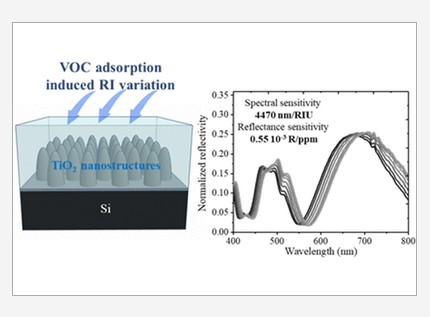"Enhanced Refractive Index Sensitivity through Combining a Sol−Gel Adsorbate with a TiO2 Nanoimprinted Metasurface for Gas Sensing" publication équipe NOVA dans ACS Applied Material and Interfaces
IM2NP MARSEILLE équipe NOVA
-
"Enhanced Refractive Index Sensitivity through Combining a Sol−Gel Adsorbate with a TiO2 Nanoimprinted Metasurface for Gas Sensing"
Mehrnaz Modaresialam, Gabrielle Bordelet, Zeinab Chehadi, Martin O’Byrne, Luc Favre, Magali Putero, Marco Abbarchi, and David Grosso
ABSTRACT: We combine a gas-adsorbent microporous hybrid silica layer and a dense TiO 2 Mie resonator array (metasurface), both obtained by sol−gel deposition and nanoimprint lithography, to form nanocomposite systems with high sensitivity for refractive index (RI) variations induced by gas adsorption. Using optical transduction based on direct specular reflection, we show spectral shifts of 4470 nm/RIU corresponding to 0.2 nm/ppm gas (air concentration) and reflection intensity changes of R* = 17 (R/
RIU) and 0.55 × 10 −3 R/ppm (air concentration). The metasurface is composed of hexagonally arranged TiO 2 nanopillar arrays, whereas the surrounding sensitive material is a class II microporous hybrid silica, containing methyl and phenyl covalently bonded organic functions. This hybrid layer shows efficient adsorption capability of volatile organic molecules such as isopropanol, which is used to induce slight variations of RI around the TiO 2 antennas. Specular reflectance variations at 45° incidence and refractive index measurements are performed using a spectroscopic ellipsometer. The presence of the titania metasurface enhances the signal by almost an order of magnitude with respect to the 2D counterpart (simulated as an effective medium approximation) and is attributed to the antenna effect, enhancing the interaction of the confined electromagnetic wave with the sensitive microporous medium. This sol−gel nanocomposite system presents many advantages such as high throughput and low-cost elaboration of elements and a high chemical, mechanical, and thermal resistance, ensuring high stability as a potential gas-sensitive nanocomposite layer for long periods. This work is a case study of improving the sensitivity of sol−gel gas-sensitive materials in optical transduction, which will be exploited in further works to develop artificial noses.
RIU) and 0.55 × 10 −3 R/ppm (air concentration). The metasurface is composed of hexagonally arranged TiO 2 nanopillar arrays, whereas the surrounding sensitive material is a class II microporous hybrid silica, containing methyl and phenyl covalently bonded organic functions. This hybrid layer shows efficient adsorption capability of volatile organic molecules such as isopropanol, which is used to induce slight variations of RI around the TiO 2 antennas. Specular reflectance variations at 45° incidence and refractive index measurements are performed using a spectroscopic ellipsometer. The presence of the titania metasurface enhances the signal by almost an order of magnitude with respect to the 2D counterpart (simulated as an effective medium approximation) and is attributed to the antenna effect, enhancing the interaction of the confined electromagnetic wave with the sensitive microporous medium. This sol−gel nanocomposite system presents many advantages such as high throughput and low-cost elaboration of elements and a high chemical, mechanical, and thermal resistance, ensuring high stability as a potential gas-sensitive nanocomposite layer for long periods. This work is a case study of improving the sensitivity of sol−gel gas-sensitive materials in optical transduction, which will be exploited in further works to develop artificial noses.
KEYWORDS: nanoimprint lithography, titania, metasurface, refractive index sensing, gas sensing, sol−gel, hybrid silica
Marco Abbarchi
Maître de conférences
Maître de conférences
NOVA Team - IM2NP - UMR CNRS 7334 Aix-Marseille Université Faculté des Sciences de Saint Jérôme, Case 142 13397 Marseille Cedex 20
Tel.: OFFICE: 0033 (0)413945388 CELL.: 0033 (0)760570716

